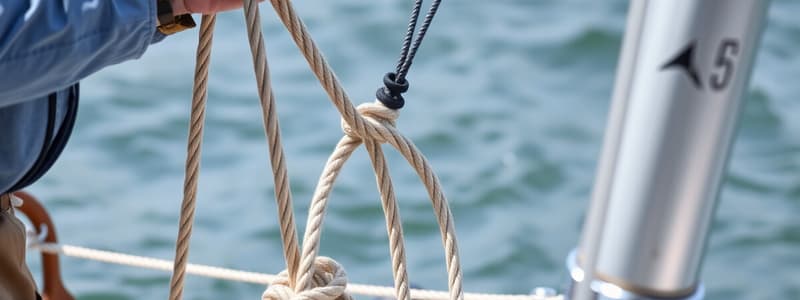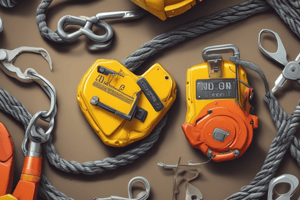Podcast
Questions and Answers
What should be the minimum peripheral length of a soft eye?
What should be the minimum peripheral length of a soft eye?
- Five times the rope lay length
- Three times the rope lay length
- Four times the rope lay length (correct)
- Six times the rope lay length
Why is a stirrup thimble used in choked situations?
Why is a stirrup thimble used in choked situations?
- To provide additional grip
- To protect the rope from damage (correct)
- To extend the lifespan of the sling
- To prevent the rope from tangling
How many tucks should be made in a hand-spliced eye against the lay of the rope?
How many tucks should be made in a hand-spliced eye against the lay of the rope?
- Five tucks (correct)
- Four tucks
- Six tucks
- Three tucks
What is a potential disadvantage of making a hand-spliced eye with tucks in the lay of the rope?
What is a potential disadvantage of making a hand-spliced eye with tucks in the lay of the rope?
What typical device has been used to make temporary eyes in wire rope?
What typical device has been used to make temporary eyes in wire rope?
Why are bulldog grips not recommended for the manufacture of slings?
Why are bulldog grips not recommended for the manufacture of slings?
In the construction of a rope sling, which part is compressed and grips the rope after assembly?
In the construction of a rope sling, which part is compressed and grips the rope after assembly?
Which splice type is less popular than the ferrule secured eye but still preferred by some users?
Which splice type is less popular than the ferrule secured eye but still preferred by some users?
What is the preferred method for rating multipurpose slings?
What is the preferred method for rating multipurpose slings?
What is the maximum angle of inclination at which a sling may be rated?
What is the maximum angle of inclination at which a sling may be rated?
What must the SWL marked on the sling be assessed by?
What must the SWL marked on the sling be assessed by?
What determines the maximum load that can be lifted by a sling?
What determines the maximum load that can be lifted by a sling?
Which material chain slings have been obsolete since the early 1980s?
Which material chain slings have been obsolete since the early 1980s?
How is a chain made?
How is a chain made?
What process does chain undergo after welding to achieve desired properties?
What process does chain undergo after welding to achieve desired properties?
What could potentially result from incorrect use of chain slings?
What could potentially result from incorrect use of chain slings?
What is the primary purpose of shackles in lifting operations?
What is the primary purpose of shackles in lifting operations?
Which material provides a higher safe working load for shackles?
Which material provides a higher safe working load for shackles?
What distinguishes shackles manufactured to older standards from those made to current standards?
What distinguishes shackles manufactured to older standards from those made to current standards?
Which type of shackle is considered most common in lifting applications?
Which type of shackle is considered most common in lifting applications?
What is a characteristic feature of current shackle standards in their sizing?
What is a characteristic feature of current shackle standards in their sizing?
What are shackles primarily made from?
What are shackles primarily made from?
Which of the following is NOT a type of shackle mentioned?
Which of the following is NOT a type of shackle mentioned?
Which shackle type is specifically referenced to include both large and small options?
Which shackle type is specifically referenced to include both large and small options?
What type of fixings are used to secure the load pin in the clevis system?
What type of fixings are used to secure the load pin in the clevis system?
Which of the following components can be used with the clevis form of chain connection?
Which of the following components can be used with the clevis form of chain connection?
What is the main advantage of using the clevis attachment system?
What is the main advantage of using the clevis attachment system?
How is the end link of the chain secured within the clevis attachment?
How is the end link of the chain secured within the clevis attachment?
What type of link connects the chain to master links in some systems?
What type of link connects the chain to master links in some systems?
What role does the load pin play in the clevis connection?
What role does the load pin play in the clevis connection?
Which factor is not one of the groups considered in the rating of chain slings?
Which factor is not one of the groups considered in the rating of chain slings?
What is NOT a fitting associated with the clevis chain connection?
What is NOT a fitting associated with the clevis chain connection?
What factors determine the amount of load carried by an individual sling leg?
What factors determine the amount of load carried by an individual sling leg?
At what maximum angle of inclination can a sling be rated without reducing its load capacity?
At what maximum angle of inclination can a sling be rated without reducing its load capacity?
What is the purpose of assessing the Safe Working Load (SWL) by a Competent Person?
What is the purpose of assessing the Safe Working Load (SWL) by a Competent Person?
Which of the following materials is NOT commonly used to manufacture textile slings?
Which of the following materials is NOT commonly used to manufacture textile slings?
What effect does a choke hitch have on sling ratings?
What effect does a choke hitch have on sling ratings?
Which of the following is a modern material used for manufacturing specialized lifting slings?
Which of the following is a modern material used for manufacturing specialized lifting slings?
What type of sling would you most likely NOT find in service today?
What type of sling would you most likely NOT find in service today?
Which factor is NOT considered when determining the maximum load a sling can lift?
Which factor is NOT considered when determining the maximum load a sling can lift?
Flashcards are hidden until you start studying
Study Notes
Rope Splicing Techniques
- Three strands are re-laid into the rope in the opposite direction to maintain the original lay.
- Ends of strands are evenly distributed around the rope for eye formation, with the ferrule compressing and gripping the rope for strength.
Soft Eye and Stirrups
- Minimum peripheral length of a soft eye must be four times the rope lay length to avoid disturbing the lay.
- Fitting thimbles for Flemish eyes is difficult; stirrup thimbles are used for protection against damage in choked situations.
Hand-Spliced Eyes
- Hand-spliced eyes involve threading individual strands back through the main body of the rope.
- Requires five tucks against the lay; tucks with the lay are banned due to potential for unravelling.
Wire Rope Grips
- Temporary eyes in wire ropes, typically used in winches, are made using clamp-type grips but are not recommended for sling manufacturing.
- Uniform load method is preferred for rating multipurpose slings; slings rated at 60° must only be used at a maximum of 45°.
- Safe Working Load (SWL) must be verified by a Competent Person and reflects Working Load Limit (WLL) under normal or special conditions.
Chain Sling Manufacturing
- Chains are produced by shaping and welding steel bars, followed by heat treatment for strength and toughness.
- Wrought iron and mild steel chain slings are obsolete, following updated safety standards.
- Clevis connections minimize components; load pins secured with spiral roll pins or circlips lock the connection.
Rating Chain Slings
- Considerations for rating include how slings attach to loads, leg geometry, and the number of legs in use.
- The angle of inclination affects load carried by each leg; choke hitch reduces ratings due to higher stress at choking points.
Textile Slings
- Manufactured from synthetic fibers like polyamide, polyester, and polypropylene; natural fibers such as manila and hemp are rarely used.
- High Modulus Polyethylene (HMPE) is a new fiber used for specialized lifting slings, complicating identification.
- An international color-coded labeling system for slings is in place to standardize markings.
Shackles as Lifting Accessories
- Shackles connect loads to lifting appliances and slings, and serve various lifting configurations.
- Main types of shackles: Bow, Dee, and Grab.
- Shackles are usually forged from steel, with higher quality steels offering higher safe working loads (SWL).
- Current standards specify maximum and minimum dimensions, contrasting with older standards that specified all dimensions fully.
- Dee shackles come in large and small sizes, with all shackle standards mandating their specifications.
Studying That Suits You
Use AI to generate personalized quizzes and flashcards to suit your learning preferences.




